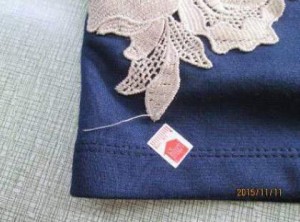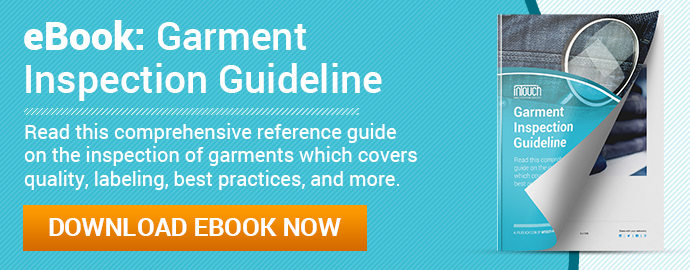 Whether you’re an end-consumer who’s just gotten their hands on the item you looked so longingly at through a store window or an importer who’s just received an order of 10,000 jackets from your supplier in Bangladesh, you can probably empathize.
Whether you’re an end-consumer who’s just gotten their hands on the item you looked so longingly at through a store window or an importer who’s just received an order of 10,000 jackets from your supplier in Bangladesh, you can probably empathize.
It’s frustrating to get less than what you expect, especially when you believe you’re paying for a higher standard of quality.
And with so many clothing brands out there competing, consumer loyalty can be hard to earn and even harder to keep.
Maybe you’re importing from one of the two global titans in the garment manufacturing arena. China accounts for almost half of the world’s global clothing exports, their “share rising from 42.6 percent in 2011 to 43.1 percent in 2013”. “Vietnamese garment exports rose by 14.85 percent in October alone. China is the only nation that surpasses Vietnam in terms of net garment exports to the U.S.”
As an importer, it pays to know what common garment defects to look for and what you can do to correct or prevent them (related: Garment Inspection Guideline [eBook]).
1. Broken, skipped or missing stitches
Broken, skipped or missing stitches occur during the sewing process and are usually attributed to either a fault with the sewing machine or a worker error.
This can be a visual issue with the product, especially in garments which use different stitching colors, like many jeans you can buy today. Stitching problems may also weaken the structural integrity of the seam, causing premature wear of the product or even ripping of the seam.
Potential reasons for broken, skipped or missing stitches
Broken stitching is often caused by rough handling. If you see stitching is missing or has been skipped, workers at your factory may be rushing to complete an order. The supplier may also have been provided an outdated specification for sewing.
"If you see stitching is missing or has been skipped, workers at your factory may be rushing. "
Stitch issues will generally be considered a minor defect, but can be major if the issue is evident on a significant portion or highly visible area of the garment.
If you find broken, skipped or missing stitches during inspection of the garments you import, voice your concerns with your supplier. The factory that produces the goods may be able to mend these in a reasonable amount of time before shipping.
2. Untrimmed threads
A very common defect, untrimmed threads are a formality in garment production. Ideally, untrimmed threads will be identified and removed during the  factory’s final production stage and internal QC check.
factory’s final production stage and internal QC check.
Although untrimmed threads are generally considered a minor defect, they can become a more serious issue if evident in a significant portion of the order.
The concern of many buyers is that untrimmed threads give the clothing a “cheap” appearance. Untrimmed threads are a sign of sloppy workmanship.
Trimming the untrimmed
The good news is that untrimmed threads are one of the more easy-to-remedy garment defects. The factory making your clothing may need to be more vigilant in looking for this issue and trimming excess material prior to packing and shipping.
3. Dimensions out of tolerance
Dimensional issues can be related to faulty patterns being used, cutting issues, incorrect stitching or inattention to tolerances by the workers. Incorrect dimensions can be particularly problematic because:
- The garment size could be affected, which means the item won’t fit the end-consumer correctly and
- The entire order quantity of that item is likely to be affected
Unlike the previous two points, garment dimensional problems typically cannot be reworked and need to be remade from scratch.
"Garment dimensional problems typically cannot be reworked and need to be remade from scratch."
Developing tolerances and points of measure
Issues related to dimensions can easily cause an entire order of product to fail product inspection. The best way to prevent these is to make sure your supplier has the correct tolerances and points of measure.
And if you have someone inspecting your product before shipping, make sure they know both the agreed tolerances and measuring methods.
Although many independent inspection firms with garment experience have developed their own tolerances for dimensions, you may have your own you’d like used for inspection. Similarly, you may have your own measuring method, which your inspector may need to be informed of prior to verifying dimensions.
4. Puckering
Puckering is an irregular seam surface. You’ll see this garment defect more commonly in woven fabrics and knitted ones. Puckering is especially prominent on garments that are tightly woven.
Causes and remedies for puckering
Puckering can be caused by the characteristics of the fabric but more commonly is related to one of the following issues related to workmanship:
- High tension on the thread during sewing, which can cause the fabric to bunch up
- Using a dull needle, which may have difficulty puncturing the fabric, or
- One ply of fabric is fed into the sewing machine at a different rate than other plies
Puckering can be considered a minor or major defect depending on the location found and severity of the distortion. Clothing affected by puckering typically cannot be reworked to remove it. Removing stitching will, at the very least, leave behind needle holes.
5. Open Seams
Open seams are both visually unappealing and weaken the integrity of the garment seams. They are almost always considered a major defect, regardless  of size. Open seams are generally not a defect present in a full order, but will be evident on isolated units due to poor folding or an incorrect technique used by the worker.
of size. Open seams are generally not a defect present in a full order, but will be evident on isolated units due to poor folding or an incorrect technique used by the worker.
Repairing an open seam tends to leave behind obvious signs of mending, such as overlapping stitching. Talk with your supplier if this kind of garment defect is present in a high number of pieces of your order and discuss ways to prevent or mitigate open seams.
6. Incorrect Stitches per Inch
Most garment specifications will specify the stitches per inch (SPI) required. This is because stitching that is less dense can compromise:
- Seam strength
- Stitching appearance, and
- Seam elasticity (on stretch fabrics)
But because a higher SPI will generally cost the manufacturer more in time and materials needed, your factory may use a lower SPI than you specify.
Managing stitch count in garments
This garment defect can also be caused by incorrect settings of the machine. A low SPI may also be due to workers intentionally lengthening the stitch in order to speed up the sewing. This is especially common where workers are paid at a piece rate, where greater focus may be placed on quantity, rather than quality.
A simple check can be performed to measure SPI with a ruler. If you carry out inspection at the factory prior to shipping, make sure your inspector is measuring and reporting SPI. Then if SPI is found to be out of tolerance, you can address this with your supplier.
Conclusion
Knowing these six common garment defects will help you be aware of issues that have plagued the garment industry for decades. While quality issues like untrimmed threads may seem commonplace and acceptable for lower-end retailers, open seams and dimension issues could result in unsellable product, product returns and damage to your brand.
By inspecting your clothing items prior to shipping, you can be sure that any garment defects or other issues have been addressed before the goods leave the factory.
Lastly, it’s important to recognize that some defective product is almost always expected in a shipment, regardless of the product being mass produced. In fact, a product inspection based on AQL, or Acceptable Quality Limits, takes this into account.
Being familiar with the AQL standard and advising your supplier of your tolerance for different types of garment defects prior to ordering can save you a lot of time and money trying to fix quality issues later.
If you enjoyed this article about garment defects, be sure to share it!







